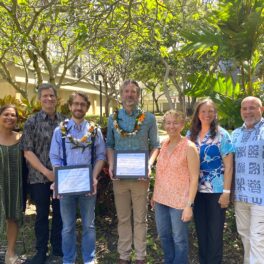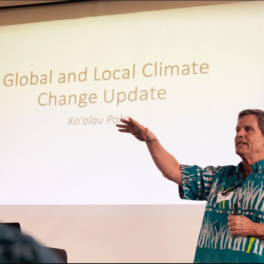Wave researcher joins SOEST ocean engineering faculty
 Justin Stopa, new faculty with Ocean and Resources Engineering.
Justin Stopa, new faculty with Ocean and Resources Engineering.
Justin Stopa recently joined the University of Hawaiʻi at Mānoa (UHM) School of Ocean and Earth Science and Technology (SOEST) as an assistant professor in the Department of Ocean Resources and Engineering (ORE). His research focus is ocean waves, in particular, extreme events which are critical for engineering design and are poorly understood. Stopa has been actively involved in ocean wave research through modeling efforts and space-based satellite technologies and has published 25 peer-reviewed scientific articles.
Prior to this new role, he was working at the L’institut Francis de Recherche pour l’Exploitation de la Mer (IFREMER) in the Laboratory of Ocean Physics and Remote Sensing, one of the premier laboratories in ocean sciences. Also while in France, Stopa was an oceanographer with an Office of Naval Research project focused on understanding the physics and sea states in the Arctic Ocean as new ocean areas open up due to melting sea ice.
He was lead author on a recent publication in the Proceedings of the National Academy of Sciences which presented the first comprehensive estimates of continent-wide wave data within the Antarctic marginal ice zone and explained how waves impact sea ice formation and development. Beginning this year, he will serve as the liaison between the European Space Agency-funded project called the Sea State Climate Change Initiative, and the Coordinated Ocean Wave Climate Project.
In 2013, Stopa earned his doctoral degree in Ocean Engineering from UH Mānoa with Kwok Fai Cheung, a professor in ORE. During his graduate studies, Stopa developed the automated wave forecast system still in operation through the Pacific Islands Ocean Observing System (PacIOOS) and assessed the wave energy potential in Hawai‘i, which is a critical component of assessing wave renewable energy.
“Since Hawai’i and low-lying Pacific islands and atolls are particularly vulnerable to climate change through sea level rise and directional changes in wave field, the University of Hawai’i at Mānoa is uniquely situated to become a leader in engineering adaptations to compensate for future dangerous environmental conditions ,” said Stopa. “I plan to pursue interdisciplinary research involving engineers, oceanographers, data scientists, and remote sensing specialists to push science and engineering further.”
“As a wave scientist and ocean engineer, I also feel it is critical to prepare the next generation for sea state changes in offshore and coastal regions,” said Stopa. “By combining my unique background in wave science, remote sensing, and international collaboration, I plan to have an impact in the community of Hawai‘i and worldwide by partnering with and educating future scientists and engineers, and through continued research at the University of Hawai‘i at Mānoa.”



